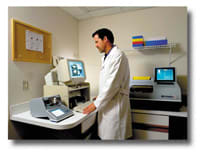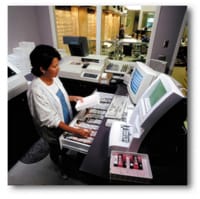Eye On Equipment
Lab ergonomics
By Susan P. Tarrant
Ergonomics is serious business. All of the time, you hear and read about how proper seating positions, computer screen positions, and general workstation layouts can lead to fewer workplace maladies such as back pain, computer vision syndrome, and carpal tunnel syndrome.
It's nothing to scoff at. Corporations spend thousands of dollars addressing the issue of ergonomics in the workplace because they understand that a little planning can help prevent injuries and increase staff productivity.
An appreciation of ergonomics is not just for corporations and factories, however. Optical labs--whether they be large wholesale operations in which employees work at the same machine throughout their entire shift, or small in-office labs in which a staffer is at the equipment for an hour or two a day--could benefit from making their lab layouts ergonomically correct.
|
|
|
|
National Optronics bases its designs on ergonomic studies for operator comfort. |
|
THE EQUIPMENT
The ergonomics of the lab equipment is given serious consideration even before pieces get to the lab.
"When we were designing our equipment, we went through all sorts of ergonomics studies," says Susan Polson of National Optronics.
The company's design team studies every aspect of the machine, from the position, angle, and height of the keypads and monitors to the overall height, width, and size of the equipment itself, making sure it provides a comfortable working experience for the operator.
"We bring in the shortest employee we have and the tallest employee we have. They use (the prototype) and give us feedback about what's awkward, what's causing them to strain, and what works well," Polson says.
Most lab equipment vendors carefully choose options including font size and the background color of monitor screens, as well as the positioning of buttons and work areas to be as easy on the operator as possible.
"We try to minimize how far an operator has to move to use the machine," says Michael Urban of Gerber Coburn.
And, recognizing that not all operators are the same size, Urban suggests that when choosing new equipment for the lab, practitioners make sure it has some level of adjustability.
"People do this for a living. We want people to be comfortable," says National Optronic's Polson, who observes, "User-friendly doesn't just mean being able to push buttons to make it work, it also means that those buttons and panels are in a comfortable location."
|
|
|
|
Adjustability of equipment to suit all sizes of operators is key, notes representatives from Gerber Coburn. |
THE LAB
Whether designing a new in-office lab space or just re-thinking your existing one, the first thing practitioners need to consider is the general workflow: How the lens jobs are going to move to and from one machine to another, or from one portion of the lab to another.
Whether your facility is strictly a finishing lab or one that is capable of doing more complex processing, the first step in designing or redesigning an ergonomically conscious lab is to understand the flow of the job through the space and the operator's movement within it.
"The most comfortable and efficient setup in the lab is a U-shape, in which the operator is very near to all the equipment in the lab," Urban says. He likens it to the perfect kitchen: "If you're chopping something, you don't want to be too far from the pot on the stove. You don't want the fridge far from the counter space and sink."
Polson says companies like hers can assist practitioners with the redesign or the creation of their labs through the utilization of a computer-assisted design program. The dimensions of the space are input, along with the equipment needed, and the best possible lab layout is produced for the client.
"We lay everything out in the order of the work process, depending on the types of jobs being done in the lab," she says. And, like Urban, she says it's done that way to avoid unnecessary steps and stretches for the operator.
"We make sure everything comes full circle, such as beginning the process and ending the process at the lensometer, because you're going to use the lensometer to place the dot for your blocking, and when the job is finished you're going to use the lensometer to test for quality and accuracy," she adds.
Eyecare practitioners also need to consider future growth as well as existing needs when laying out their lab spaces. "If you put everything in there tight as a drum, you're going to have no room to add something like a tinter down the line," Polson says.
What's ergonomic for one level of productivity may not be so for another level of productivity, Urban adds.
"Often, the tracer is at the back corner of the edger. That's fine if I have just a couple of jobs to do in a shift. But if I'm suddenly doing 20 jobs, I'm now repeatedly standing and stretching and leaning over the equipment. My weight is now on the front of the equipment, I'm off balance, and I'm uncomfortable. So, you've really got to keep an increase in business in mind," he says.
While lab layout and the actual design of the equipment may seem obvious areas to practice ergonomics, there are elements such as bench height, cabinet location, and seating to be considered as well. All of the factors contribute to the ergonomic nature of the operator's workspace.
THE OPERATOR
"When looking at the equipment you have in the lab, remember that it is not all designed the same way," Urban says. Some machines may be designed with a horizontal orientation, while others have a vertical orientation. That's important to understand when considering factors like bench height.
"For some edgers that work horizontally, it may be too high to comfortably work at a standard bench height (typically 36 inches)," he says. "A lot of times the operator will find himself having to stand to do the job. If you're selecting equipment, you need to understand where the operator is going to be--where his hands are going to be."
Urban says his team will often work with carpenters when helping a customer design a lab space, so that benches can have a custom height if needed. The positioning of cabinetry is also important so that it is easily accessible. "Ergo-nomics should definitely not be underestimated," Urban states.
Even if you've had an in-office lab for years, it's always a good idea to give it a "check up" regarding efficiency and ergonomics. Consult your vendor about whether your layout is meeting your needs as well as the needs of your operator, especially if the number of jobs you do has changed over time. There might be something you could remove to make more room, or an adjustment in equipment placement or cabinetry height may make a fit.
It's worth the time to investigate, and your vendor can help you. What you'll get out of it is happier, healthier employees, and therefore more productive and efficient employees.





